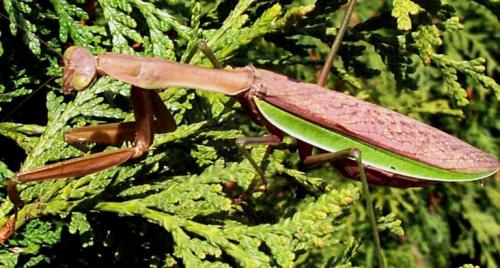Ootheca treasures found in the winter garden
Strange egg cases are the over-wintering life stage of the praying mantid.

A warm day in January provided a great opportunity to check out my landscape. A trail through the lawn indicated voles fed on the grass under piles of snow back in December. A spirea shrub was missing a few branches thanks to a rabbit, often seen from a kitchen window, over the past few months. Fortunately, there was no serious damage. I did find signs of another critter, but not one that will damage my plants. At the top of a large viburnum were strangely shaped egg cases. These egg cases were light brown, about 1.5 inches wide and looked like foam insulation. What a treasure—an ootheca! These egg casings, or oothecae, were of praying mantids. One egg case can contain 100 or more eggs.
Glancing around the garden, I found three more oothecae of varying sizes. Next year’s garden will have numerous predators stalking the plants for insects and spiders. Mantids are indiscriminate in their feeding habits, eating anything they can capture. Unfortunately, some of the prey they capture and eat may include bees and other beneficial insects. They also can be cannibalistic.
Praying mantids are the perfect hunter, moving very slowly, with body colors of brown or green that help them blend into the plants where they hunt. Blending in is an important defense since they are also the prey of frogs, birds and bats. Praying mantids have several tools to help them capture unsuspecting creatures, including a head that swivels 180 degrees, large eyes and front legs with spines for holding their prey. This slow-moving predator is not likely to greatly reduce pests in the garden since they also feed on flies, moths, bees and other insects that are not garden pests.
Often called praying mantis, scientists shy away from this name since it refers to the genus Mantis that does not include all of the related insects in this family. The largest praying mantid in Michigan is the Chinese mantid, Tenodera sinensis, at 3-5 inches. A smaller mantid also found in Michigan is the European mantid, Mantis religiousa, which is pale green and about 3 inches long.

Chinese mantid, Tenodera sinensis. Photo: Curtis E. Young, The Ohio State University, Bugwood.org
Whether you call them mantis or mantid, these large insects are some of the most interesting creatures you will find in landscapes and gardens. Both of these species were introduced into the United States in the late 1800s. The southeastern portion of the country is home to a native species, the Carolina mantid, Stagmomantis carolina. This smaller mantid is about 2 inches long and feeds mostly on arthropods.
It is a wonder to watch such a slow-moving creature stalk its prey. It is even more a wonder how this slow moving hunter possibly comes across enough food to keep it alive. Patience is really the name of the game for the praying mantid.



 Print
Print Email
Email




